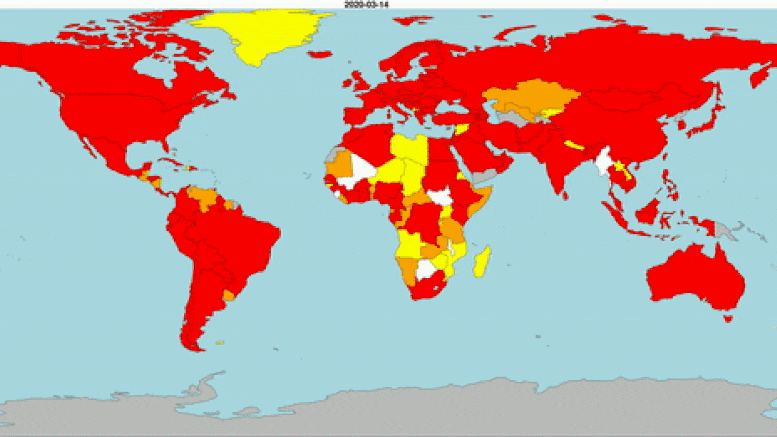When Did the First COVID-19 Case Arise? New Analysis With Surprising Findings
0 View
Share this Video
- Publish Date:
- 28 June, 2021
- Category:
- Covid
- Video License
- Standard License
- Imported From:
- Youtube
Tags

Image shows global COVID-19 spread across countries over time. Countries highlighted in yellow – upper bound of a 95% confidence interval from the estimated date of origin contain a particular date (ie the probability of the country already experiencing the first case is more than 5%); countries marked in orange – estimated date of origin was already on that date (i.e. date of origin indicates that the COVID-19 is already spreading in the country); countries highlighted in red: the first reported case already occurred on that date; countries marked in grey-insufficient data for origin dating. Map layers were created using the R package rworldmap, version 1.3-6 (https://cran.r-project.org/web/packages/rworldmap). Credit: Roberts DL et al., 2021, PLOS Pathogens, CC-BY 4.0
New analysis suggests a much earlier, faster spread of COVID-19 than confirmed cases suggest.
Using conservation science methods, a new analysis suggests the first case of COVID-19 originated in China between early October and mid-November 2019, with the most likely date of origin being November 17. David Roberts of the University of Kent, UK and colleagues present these findings in the open-access journal PLOS Pathogens.
The origin of the ongoing COVID-19 pandemic remains unclear. The first officially identified case took place in early December 2019. However, there is mounting evidence that the original case may have surfaced even earlier.
To help clarify the timing of the onset of the pandemic, Roberts and colleagues reused a mathematical model originally developed by conservation scientists to determine the date of a species’ extinction, based on recorded sightings of the species. For this analysis, they reversed the method to determine the date when COVID-19 most likely originated, according to when some of the earliest known cases occurred in 203 countries.
The analysis suggests that the first case in China occurred between early October and mid-November 2019. The first case most likely occurred on November 17, and the disease spread globally by January 2020. These findings support growing evidence that the pandemic broke out earlier and more quickly. . grew faster than was officially believed.
The analysis also identified when COVID-19 is likely to have spread to the first five countries outside of China, as well as to other continents. For example, it estimates that the first case outside of China occurred in Japan on January 3, 2020, the first case in Europe on January 12, 2020 in Spain, and the first case in North America on January 16 in the United States. , 2020.
The researchers note that their new method could be applied to better understand the spread of other infectious diseases in the future. Meanwhile, a better understanding of the origins of COVID-19 could improve understanding of its ongoing spread.
Roberts adds: “The method we used was originally developed by me and a colleague to date extinctions, but here we use it to date the origin and spread of COVID-19. This new application in the field of epidemiology offers a new opportunity to understand the origin and spread of disease as only a small amount of data is needed.”
Reference: “Dating First Cases of COVID-19” by David L. Roberts, Jeremy S. Rossman, and Ivan Jarić, June 24, 2021, PLOS Pathogens.
DOI: 10.1371/journal.ppat.1009620
Funding: IJ was funded by The JE Purkyn? Fellowship of the Czech Academy of Sciences. DLR and JSR did not receive specific funding for this work. The funders had no role in the study design, data collection and analysis, the decision to publish the manuscript, or preparation of the manuscript.










